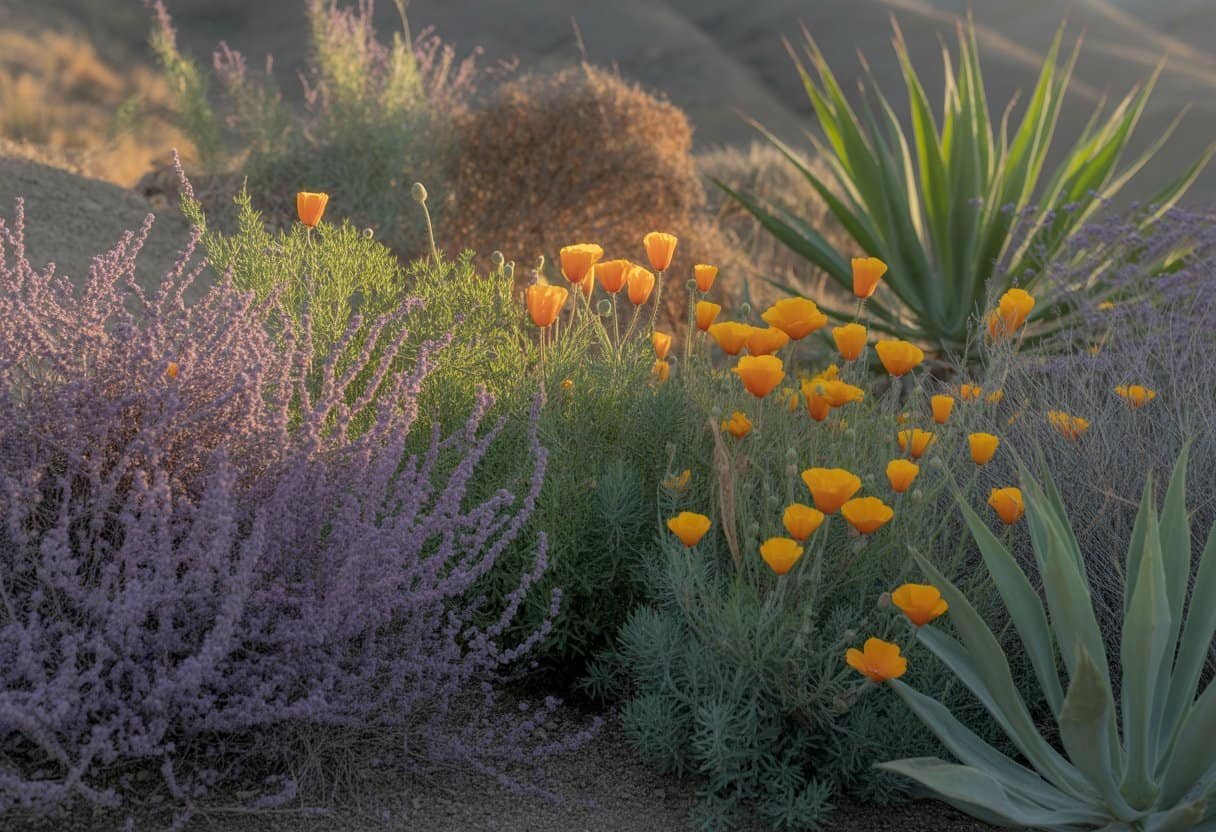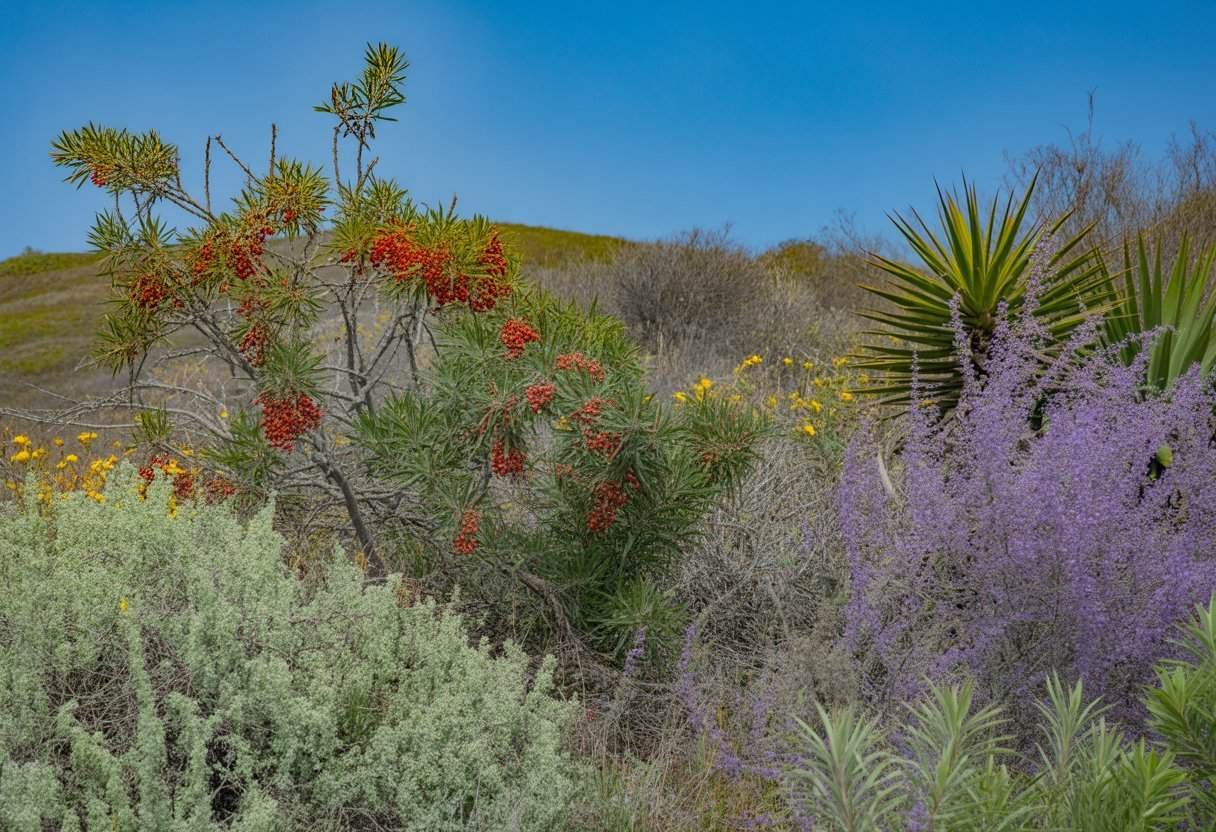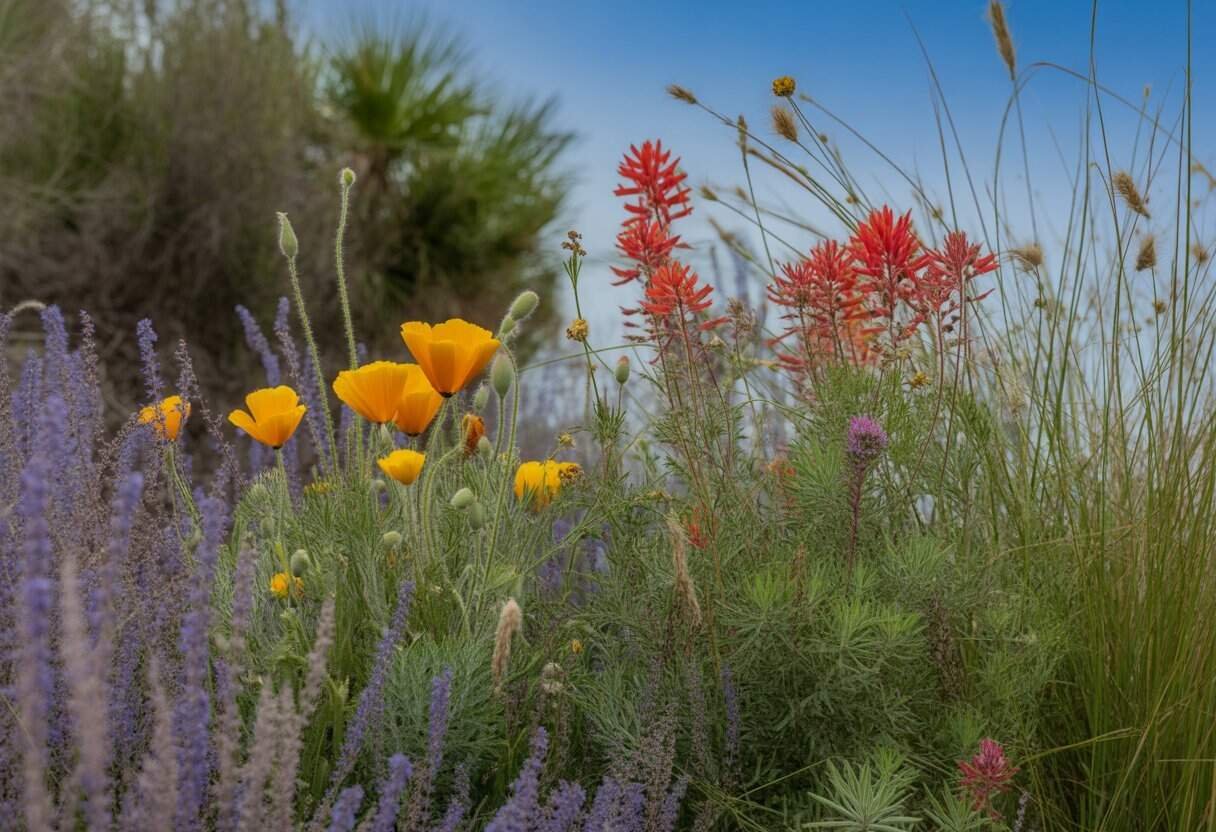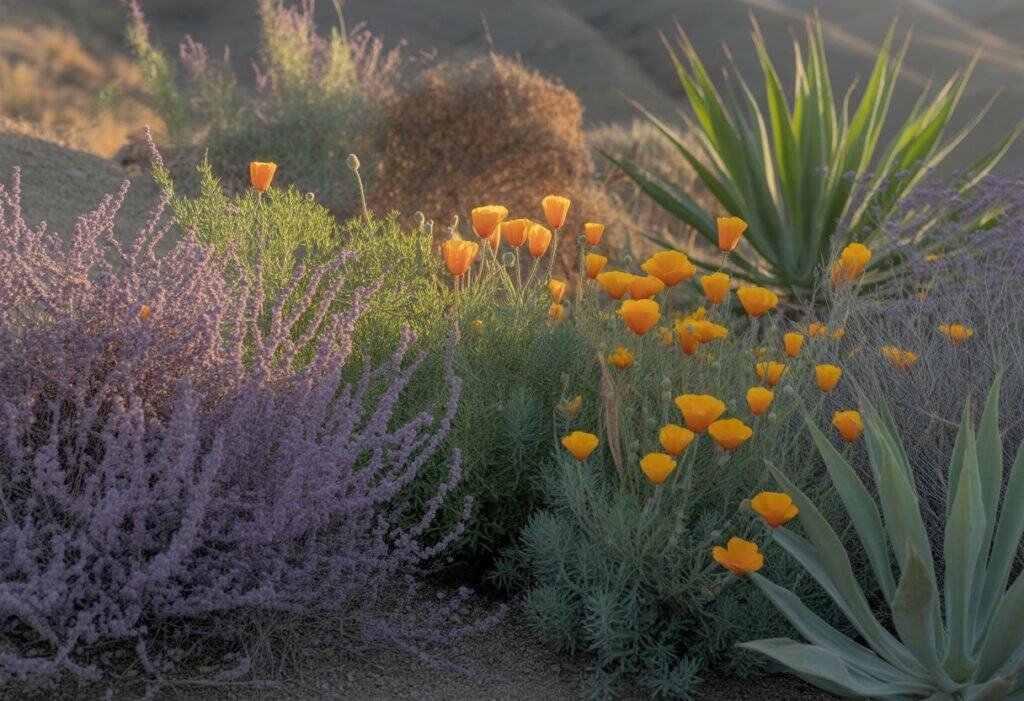Los Angeles native plants thrive in our region’s unique climate and soil conditions. These plants evolved over thousands of years to survive with little water, making them great for sustainable landscaping.
Native plants support local ecosystems by providing food and habitat for birds, butterflies, and other wildlife.

Many homeowners now use native plants to create beautiful, low-maintenance gardens that connect to Southern California’s natural heritage. Native gardens can range from colorful wildflower meadows to elegant arrangements of sages, buckwheats, and manzanitas.
These gardens offer year-round interest while needing far less water and care than conventional landscapes.
Key Takeaways
- Los Angeles native plants need minimal water and maintenance.
- Native gardens support local wildlife including birds, butterflies, and beneficial insects.
- Using native plants helps preserve Southern California’s natural heritage and reduces environmental impact.
Understanding Los Angeles Native Plants
Native plants have shaped Los Angeles landscapes for thousands of years. They adapt perfectly to the region’s Mediterranean climate.
These plants benefit local ecosystems and need less maintenance and resources than non-native alternatives.
Defining Native Plants
Native plants are species that evolved naturally in a specific region without human introduction. In Los Angeles, these plants developed over millennia to thrive in the area’s unique climate.
They survive the region’s long, dry summers and mild, wet winters.
Los Angeles native plants include:
- California poppy – the state flower with bright orange blooms
- Coast live oak – an evergreen tree providing vital habitat
- White sage – an aromatic shrub with cultural significance
- Toyon – a red-berried shrub also known as “California holly”
These plants have deep root systems that help them access water during drought periods. They also conserve water with small leaves or waxy coatings.
Benefits of Native Species
Native plants offer practical advantages for Los Angeles residents. They use far less water than non-native plants, reducing water bills and conserving a precious resource.
Once established, native plants need little fertilizer and resist local pests and diseases. They require less pruning and thrive without pesticides.
These traits make them economical and environmentally friendly choices for landscaping. Native gardens reduce yard work and create beautiful, sustainable spaces.
Native plants also connect residents to the region’s natural heritage. Their seasonal changes reflect the authentic rhythms of Southern California’s ecosystem.
Importance for Los Angeles Ecosystems
Los Angeles native plants form the foundation of healthy local ecosystems. They provide essential food and shelter for native wildlife.
Many local birds, butterflies, and bees rely on native plant species.
Native plant communities prevent erosion on hillsides. Their deep roots stabilize soil and absorb rainwater effectively.
Native plantings improve climate resilience. As Los Angeles faces higher temperatures and drought, native plants withstand these challenges.
Replacing hardscape or lawn with native landscaping helps cool neighborhoods and reduces air pollution. Native plants also capture carbon dioxide.
Native Plant Communities and Key Species

Los Angeles supports diverse native plant communities adapted to the region’s Mediterranean climate. These communities provide habitat for wildlife and showcase plants that thrive with minimal water and care.
Chaparral and Coastal Sage Scrub
Chaparral and coastal sage scrub cover the hillsides and coastal areas of Los Angeles. These communities evolved to withstand drought, fire, and poor soils.
California sagebrush (Artemisia californica) defines the coastal sage scrub with its gray-green foliage and aroma. Black sage (Salvia mellifera) grows nearby and attracts many pollinators with purple flowers.
Bush monkey flower (Mimulus aurantiacus) adds orange or yellow blooms from spring through summer. This drought-tolerant shrub provides nectar for hummingbirds and butterflies.
Chaparral yucca (Hesperoyucca whipplei) stands out with its tall flower stalk reaching up to 12 feet. The plant lives for several years, flowers once, then dies after setting seed.
Oak Woodland and Riparian Zones
Oak woodlands create shaded canopies in canyons and north-facing slopes. Coast live oak (Quercus agrifolia) serves as the cornerstone species and can live for hundreds of years.
These evergreen trees create their own microclimate beneath their wide canopies. Wildlife depends on acorns for food, and the trees provide nesting sites for birds.
Riparian zones along streams support willows, sycamores, and cottonwoods. These water-loving plants stabilize banks and filter pollutants.
Understory plants in these areas include ferns, wild roses, and native grasses that grow well in filtered sunlight and slightly higher moisture.
Signature Shrubs and Groundcovers
Los Angeles native shrubs provide year-round structure and seasonal interest. Toyon (Heteromeles arbutifolia) produces bright red berries in winter, earning the nickname “Christmas berry.”
Lemonade berry (Rhus integrifolia) grows as a dense evergreen shrub with pink-white flowers and sticky red fruits. The fruits can be soaked in water to make a refreshing drink.
Several Ceanothus species, or California lilac, cover hillsides with blue or white flowers in spring. These shrubs fix nitrogen and improve soil quality.
Manzanita varieties have smooth red bark and bell-shaped flowers. Their forms make striking focal points in native gardens.
Popular Native Flowers and Grasses

Los Angeles native plants offer beautiful blooms and grasses that thrive in our Mediterranean climate. These plants need less water and maintenance while providing habitat for native wildlife.
Colorful Perennials and Wildflowers
The California Poppy (Eschscholzia californica) is California’s state flower, with bright orange blooms from February through September. These drought-tolerant plants love full sun and self-seed easily.
Fire Poppy (Papaver californicum) produces delicate salmon-pink flowers that often appear after wildfires.
Showy Penstemon (Penstemon spectabilis) displays vibrant purple-blue tubular flowers on tall stems, attracting hummingbirds and native bees. This perennial thrives in well-drained soil and tolerates drought once established.
California Fuchsia (Epilobium canum) produces red-orange tubular flowers in late summer through fall. Hummingbirds especially love these blooms when other nectar sources are scarce.
Golden Yarrow (Eriophyllum confertiflorum) offers clusters of yellow flowers from spring through summer. This tough native grows well on slopes and feeds beneficial insects.
Essential Native Grasses
Purple Needlegrass (Stipa pulchra), California’s state grass, forms elegant clumps with purple-tinged seed heads. This drought-tolerant grass can live for centuries with roots extending up to 16 feet underground.
Deer Grass (Muhlenbergia rigens) creates fountain-like forms reaching 3-5 feet tall. The arching flower stalks add movement and texture to gardens.
Native grasses provide crucial wildlife habitat and year-round interest. They need minimal maintenance and typically require cutting back once a year.
Bunch grasses work well as accent plants, border elements, or mass plantings. Their varied textures and heights add depth to native gardens, and their roots help prevent erosion.
Unique Annual Blooms
Annual wildflowers create spectacular seasonal displays in Los Angeles gardens. These plants complete their life cycle in one season and produce seeds for next year’s growth.
California Wildflower Mixes often include baby blue eyes, farewell-to-spring, and tidy tips. These mixtures provide a changing palette of colors in spring.
Plant native annual seeds in fall before winter rains for best results. Lightly rake the soil to ensure good contact without burying seeds too deeply.
Annual natives need little care beyond initial establishment. Avoid fertilizers, which can favor non-native weeds over native species.
After flowering, let plants set seed before removing spent growth.
Supporting Wildlife and Pollinators
Native plants provide food and shelter for local wildlife. These natural relationships have evolved over thousands of years, creating balanced ecosystems that support biodiversity in Los Angeles.
Attracting Hummingbirds and Butterflies
Los Angeles gardens can attract pollinators with the right plant choices. Monarch butterflies depend on native milkweed species to reproduce. They lay eggs on these plants, and their caterpillars feed on the leaves.
Hummingbirds visit tubular, brightly colored flowers with high nectar content. The California Blue Elderberry (Sambucus cerulea) produces clusters of small flowers that hummingbirds visit often. This plant also produces berries that feed over 50 species of birds.
Common Buckwheat (Eriogonum fasciculatum) attracts many butterfly species with its clusters of pinkish-white flowers. It’s drought-tolerant and provides nectar throughout summer.
California Aster blooms in late summer and fall, offering crucial late-season nectar for butterflies.
Habitat Restoration for Native Wildlife
Creating wildlife-friendly spaces needs more than planting flowers. Native gardens should include:
- Layered vegetation: Trees, shrubs, and ground covers
- Water sources: Bird baths or small ponds
- Shelter options: Rock piles, brush heaps, or fallen logs
Coyote Mint attracts beneficial insects that help control garden pests. Its aromatic foliage deters some herbivores, and its flowers support native bees.
Leaving some areas of the garden less manicured creates natural habitat for ground-dwelling creatures. Many native bees nest in bare soil patches or hollow plant stems.
Avoid pesticides to protect beneficial insects and wildlife.
Role of Native Plants in Urban Areas
Urban native plant gardens serve as stepping stones for wildlife moving across developed areas. Even small yards can become important refueling stations for migrating species.
Native plant communities in cities help restore ecological functions. They filter rainwater, improve air quality, and add climate resilience with deep root systems.
Los Angeles faces challenges with heat islands and water scarcity. Native plants evolved here to handle these conditions while supporting wildlife.
School gardens with natives like California Blue Elderberry and Common Buckwheat create outdoor classrooms. Students can observe butterfly life cycles and plant-pollinator interactions.
Community gardens with native sections show sustainable landscaping in action. They demonstrate how beautiful, drought-tolerant, wildlife-supporting gardens can be.
Gardening and Landscaping With Los Angeles Natives
Native plants offer practical and beautiful solutions for Los Angeles gardens. They need less maintenance and water while providing habitat for local wildlife.
Design Principles for Native Gardens
Creating a native garden starts with planning. Group plants with similar water needs together, a technique called hydrozoning.
This prevents overwatering some species while underwatering others.
Consider plant heights and seasonal changes when designing. Place taller plants like elderberry or toyon at the back, mid-height sages and buckwheats in the middle, and ground covers like manzanita at the front.
Add walking paths made of decomposed granite or flagstone for access throughout the garden. These materials complement native plants and let water soak into the soil.
Leave open space between mature plants. Native plants often look best in natural groupings rather than formal rows.
This spacing also improves air circulation and reduces disease problems.
Drought-Tolerant Landscaping
Los Angeles natives excel in drought conditions once established. Plants like California poppy, white sage, and California lilac thrive with minimal supplemental water.
Replace lawn areas with native meadow plants such as purple needlegrass or blue-eyed grass. These create texture and movement while using much less water.
Add mulch layers 2-3 inches deep around plants to retain moisture and suppress weeds. Keep mulch away from plant stems to prevent rot.
Hardscape elements like boulders, dry creek beds, and decorative gravel reduce water needs and add visual interest. These features capture rainwater during storms and direct it to planted areas.
Install a simple drip irrigation system for the first 1-2 years to help plants establish. Most natives need little or no irrigation once established.
Soil and Watering Considerations
Most Los Angeles native plants prefer well-draining soil. Amend heavy clay soils with coarse sand or pumice to improve drainage.
Avoid adding too much organic matter, as many natives evolved in lean soil. Water deeply but infrequently to encourage deep root growth.
For most established natives, watering once every 2-4 weeks during summer is enough. Turn off irrigation systems during the winter rainy season.
Test soil drainage by digging a 12-inch hole, filling it with water, and watching how quickly it drains. If water remains after an hour, improve drainage before planting.
Many natives are sensitive to summer irrigation. Plants like manzanita, ceanothus, and some sages can develop root rot if watered during hot weather.
Plan summer watering based on each species’ needs. Avoid fertilizing native plants, as most thrive without extra nutrients.
Plant Selection and Sourcing
Selecting appropriate native plants creates a sustainable Los Angeles garden. Reliable sources help you find healthy plants that will thrive in your conditions.
Choosing the Right Plants for Your Site
Start by assessing your garden’s sunlight, soil type, and available space. Most LA natives prefer full sun and well-draining soil, but some grow well in shade or wetter areas.
Consider your garden goals. Native plants can attract pollinators, create habitat, or conserve water.
Match plants to your microclimate. Coastal areas differ from inland valleys, so choose plants from your specific region for best results.
Look for plants that naturally grow together. This approach creates balance and reduces maintenance.
Los Angeles Native Plant Nurseries
The Theodore Payne Foundation in Sun Valley offers a wide selection of native plants and expert advice. Their staff can help match plants to your conditions.
LA Native Plant Source provides locally grown natives with detailed habitat information. They specialize in Southern California ecosystems.
Several neighborhood nurseries now offer sections dedicated to native plants. These local businesses carry plants adapted to their immediate area.
Seasonal native plant sales offer chances to find rare species. The California Native Plant Society hosts regular events with knowledgeable volunteers.
When visiting a nursery, ask about the origin of their plants. Local genetic stock adapts better to LA conditions than distant sources.
Stewardship, Conservation, and Cultural Connections
Native plants in Los Angeles connect to cultural heritage and environmental conservation. Protecting them involves understanding history and using modern restoration practices.
Indigenous Peoples and Native Plants
The Tongva (Gabrielino), Chumash, and other indigenous peoples maintained close relationships with Los Angeles native plants for thousands of years. They used native plants like white sage (Salvia apiana) for medicine, ceremony, and daily life.
California oak trees provided acorns, a staple food processed through complex methods. Indigenous knowledge included sustainable harvesting to keep plant populations healthy.
Many tribes managed the land with controlled burns that promoted native plant growth and reduced wildfire risk. This stewardship maintained biodiversity and ecosystem health.
Today, indigenous communities advocate for native plant protection and access to traditional gathering sites. Organizations like the Wishtoyo Chumash Foundation work to preserve cultural practices and the plants central to them.
Conservation and Habitat Restoration
Los Angeles has lost over 90% of its native wetlands and significant woodland areas to development. Conservation efforts now focus on restoring these vital ecosystems.
The Los Angeles River Revitalization project uses native plants to rebuild riparian habitats and provide flood control. Native plants need less water and maintenance than non-natives once established.
Organizations like the Theodore Payne Foundation and California Native Plant Society offer resources for restoration projects. They provide seeds, plants, and knowledge for large and small restorations.
Community-based efforts have transformed areas like the Baldwin Hills Scenic Overlook and Madrona Marsh. These projects remove invasive species and reintroduce native plants for local wildlife.
School gardens with native plants teach new generations about local ecology and create habitat islands in urban areas.
Frequently Asked Questions
Los Angeles gardeners often have questions about native plants, including identification, purchasing, and their unique features.
What are some popular native plants suitable for landscaping in Los Angeles?
California poppy thrives in Los Angeles with bright orange blooms and drought tolerance. These wildflowers add color and need little water.
White sage offers silvery foliage and white flowers that attract pollinators. It performs well in hot, dry Southern California conditions.
Cleveland sage grows beautifully in Los Angeles gardens, with aromatic purple flowers and gray-green leaves. Hummingbirds and bees love this plant.
Toyon, or California holly, features red berries in winter and provides habitat for birds. This shrub can grow large, making it good for privacy or as a focal point.
How do you identify native plants in the Los Angeles region?
Native plants in Los Angeles often have small, leathery leaves to minimize water loss. Many display silvery or gray foliage to reflect sunlight.
They usually have deep root systems that access underground water. These roots help them survive long dry periods.
Field guides for Southern California flora are helpful for identification. The Theodore Payne Foundation offers plant ID workshops year-round.
Mobile apps like iNaturalist and Calflora use photo recognition to identify native species. You can take pictures of unknown plants for instant identification.
Where can one purchase native plants in Los Angeles?
Theodore Payne Foundation in Sun Valley specializes in California native plants. Their nursery offers a wide selection and expert advice.
Tree of Life Nursery in San Juan Capistrano has an extensive inventory of native plants. They also offer workshops on native plant care and landscape design.
The Rancho Santa Ana Botanic Garden’s Grow Native Nursery in Claremont sells plants from their collections. Their staff can help with plant selection for your garden.
Botanical gardens throughout Los Angeles host seasonal native plant sales. The Los Angeles Arboretum and South Coast Botanic Garden offer unique varieties at annual sales.
What are the characteristic features of Southern California native plants?
Drought tolerance defines most Los Angeles native plants. Many can survive on seasonal rainfall after establishment.
Fire adaptation is common, with some species needing fire to germinate. Others resprout quickly from roots after wildfires.
Seasonal dormancy helps natives survive heat and drought. Many appear brown in summer but revive with fall and winter rains.
Native plants support wildlife, offering habitat and food for birds, butterflies, and bees. Native oak trees alone support hundreds of insect species.
Which native trees are most commonly found in Los Angeles?
Coast live oak dominates many natural areas with its broad canopy and evergreen leaves. These trees can live for centuries and support diverse wildlife.
California sycamore lines many waterways with its mottled bark. It provides excellent shade and bird habitat.
Western redbud puts on a spring show with magenta flowers before leaves appear. This smaller tree fits well in urban gardens.
Catalina ironwood, with smooth gray bark and feathery leaves, thrives in coastal neighborhoods. This elegant tree tolerates poor soil and coastal conditions.
What are the initiatives for obtaining free California native plants?
The City of Los Angeles offers free street trees through the City Plants program. Many native species are available, and staff will even handle the planting.
Tree seedling giveaways happen regularly at environmental events throughout Los Angeles County. The Forest Aid program gives out thousands of native tree seedlings every year.
Several public libraries have seed libraries that provide free native plant seeds. You can “borrow” seeds, grow plants, and return collected seeds at the end of the growing season.
Community garden plant swaps offer chances to get native plants for free. Experienced gardeners often divide established natives and share them with neighbors.


